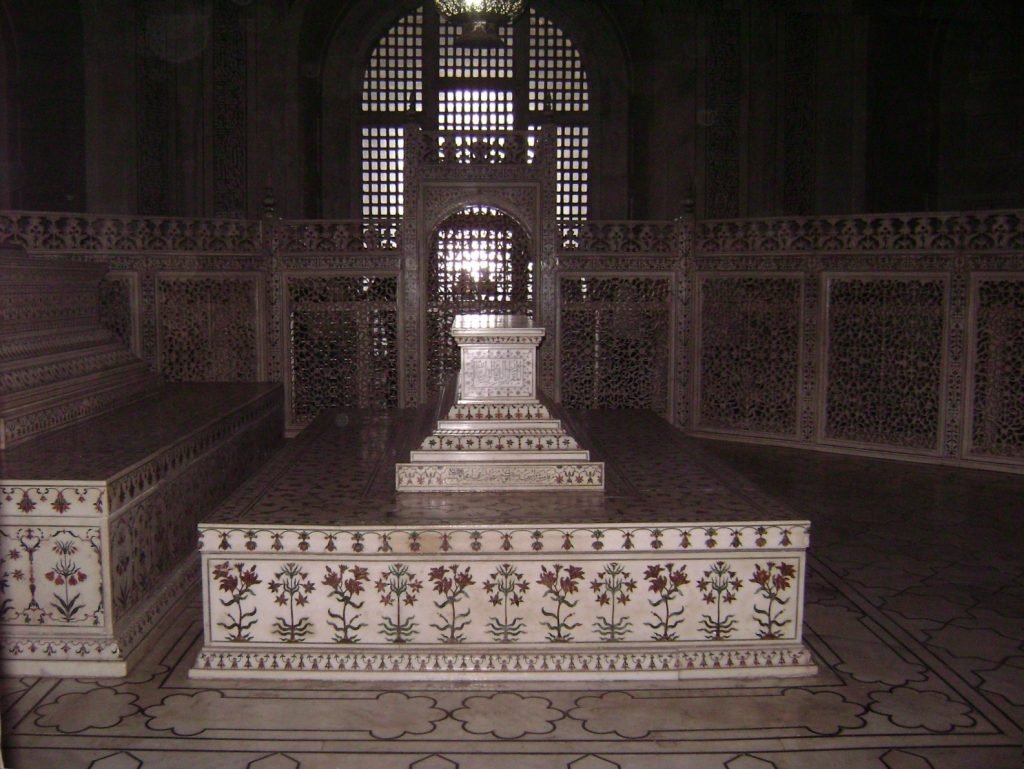Arjumand Banu Begum, famously known as Mumtaz Mahal, was the beloved Empress and principal wife of Shah Jahan, the fifth Mughal Emperor. Their enduring love story is immortalized through the breathtaking Taj Mahal, a mausoleum built by Shah Jahan in memory of Mumtaz Mahal. This architectural marvel stands as a testament to their deep affection and the grandeur of Mughal artistry. Alamgir Khan – Taj Mahal Guide and Travel Experts offers insightful tours that explore the rich history of Shah Jahan and Mumtaz Mahal, delving into the romance and legacy that continues to captivate visitors from around the world.
Arjumand Banu Begum: The Birth of a Mughal Empress
Arjumand Banu Begum, born on April 6, 1594, was the cherished wife of Prince Khurram, who later ascended as the fifth Mughal Emperor Shah Jahan. Their marriage, celebrated in April 1612 in Agra, marked the beginning of a profoundly successful union. Shah Jahan and Mumtaz Mahal’s relationship was exceptional, with Arjumand Banu Begum capturing Shah Jahan’s heart even more deeply than Nur Jahan had captivated Jahangir. This deep bond was not merely romantic but also a source of great personal and political strength.
Discover the legacy of Arjumand Banu Begum at the Taj Mahal. Explore the timeless love story and grand Mughal artistry. Book your tour today!
Alamgir Khan – Taj Mahal Guide and Travel Experts emphasizes that Arjumand Banu Begum’s role went beyond that of a mere consort. She was a steadfast partner who shared Shah Jahan’s joys and sorrows, supporting him through significant political challenges. Her unwavering support was evident during Shah Jahan’s rebellious campaigns across the Deccan, Orissa, Bengal, and Bihar, and she bore 14 of their 18 children. Arjumand Banu Begum’s companionship was integral to Shah Jahan’s life, and her legacy is eternally etched in the magnificent Taj Mahal, a symbol of their undying love.
Arjumand Banu Begum was honored with the title of ‘Mumtaz Mahal’ upon her promotion as Shah Jahan’s chief wife. Tragically, she passed away on June 17, 1631, while Shah Jahan was engaged in a campaign in the Deccan. Alamgir Khan – Taj Mahal Guide and Travel Experts highlights how the profound love between Shah Jahan and Mumtaz Mahal is immortalized in the magnificent Taj Mahal, a testament to their enduring bond.
Good To Know – Taj Mahal Day Tours Book Your Private Visit
- Exclusive Access: Enjoy a luxurious, private day tour with tailored itineraries that highlight the best of the Taj Mahal without the crowds.
- Personalized Experience: Book your private visit to receive a custom-crafted tour designed to match your interests and schedule.
- Seamless Travel: Arrive comfortably from Delhi Airport with our seamless, all-inclusive day trip, ensuring a stress-free adventure.
- Expert Guidance: Benefit from knowledgeable guides who provide in-depth insights and adapt your itinerary to enhance your Taj Mahal experience.
- Memorable Moments: Capture the beauty of the Taj Mahal at your own pace, with a focus on comfort and exclusivity for a truly unforgettable visit.
You also like to read:
- How Many Days in Agra: You Need to Stay and Where to Satisfy Your Taste Buds!
- Delhi Airport to Agra Transfer with Fatehpur Sikri Visit: A Must-Do Journey
- Agra Street Food Tour with Spice Market by Tuk-Tuk
- Sunrise Taj Mahal Agra Fort with Mehtab Bagh Tour by Tuk Tuk
- The Enchanting Story of Mumtaz Mahal: Unveiling the Real Photo and History
- How many days should you stay in Agra to see all the sights?
- Unveiling the Best Time to Witness the Majestic Beauty of the Taj Mahal

Arjumand Banu Begum, later known as Mumtaz Mahal, was a profoundly educated and accomplished woman of exceptional beauty and intellect. Her natural grace and deep compassion were evident through her charitable actions, particularly her support for widows, orphans, and those in distress. Mumtaz Mahal was also a devout and pious individual, dedicated to Islamic practices and religious observances, which further highlighted her noble character. Her contributions to society and her charitable endeavors made her a beloved figure beyond her role as Shah Jahan’s wife.
Alamgir Khan – Taj Mahal Guide and Travel Experts underscores that Shah Jahan’s deep affection for Mumtaz Mahal is immortalized in the iconic Taj Mahal, which stands as the ultimate symbol of his love and devotion. The grandeur of the Taj Mahal reflects not only the architectural brilliance of the Mughal era but also the profound bond between Shah Jahan and Mumtaz Mahal. This mausoleum, covering her mortal remains, remains a timeless monument to their enduring love and loyalty.
Arjumand Banu Begum, known as Mumtaz Mahal, was a prominent figure in the Mughal court, distinguished by her notable role and high honor as the keeper of the Mehr Uzaz, the seal of the land. Her intellectual prowess and fluency in Arabic and Persian set her apart as a learned princess, further enhancing her esteemed position within the court. Her nature and humility were widely admired throughout Agra, endearing her to nobles and officials alike. This widespread respect and admiration facilitated her marriage to Shah Jahan, as her father Jahangir, the reigning Emperor, was readily supportive of the union.
Alamgir Khan – Taj Mahal Guide and Travel Experts emphasizes that the affection and reverence Shah Jahan held for Mumtaz Mahal are vividly reflected in the grandeur of the Taj Mahal. The mausoleum not only serves as a tribute to their love but also as a testament to Mumtaz Mahal’s significant role and impact in Mughal history. The enduring legacy of Shah Jahan and Mumtaz Mahal’s relationship is immortalized in this magnificent monument, celebrating their profound bond and the respect she garnered within the Mughal Empire.
Although Mumtaz Mahal was engaged to Shah Jahan in 1607, she became his second wife due to political circumstances that required Shah Jahan to marry his first wife between 1607 and 1612. Unfortunately, Mumtaz Mahal passed away on June 17, 1631, while delivering their 14th baby. Alamgir Khan – Taj Mahal Guide and Travel Experts notes that the profound love Shah Jahan had for Mumtaz Mahal is immortalized in the Taj Mahal, a magnificent tribute to their enduring bond. This iconic mausoleum, built to honor Mumtaz Mahal, reflects the deep affection and respect Shah Jahan held for his beloved wife.
The Cenotaph of Arjumand Banu Begum: A Tribute to Mumtaz Mahal
The Taj Mahal was commissioned by Emperor Shah Jahan in memory of his beloved empress, Arjumand Banu Begum, known as Mumtaz Mahal, following her death in 1631. Constructed from the world’s finest marble, sourced from Makrana near Jaipur, this architectural marvel took 22 years to complete. It employed around 20,000 artisans from across Asia, reflecting the grandeur and intricate craftsmanship of the Mughal era. The mausoleum, along with its surrounding structures, is thoughtfully arranged within a garden divided into four sections by raised walkways and water channels, creating a serene and symmetrical landscape.
Alamgir Khan – Taj Mahal Guide and Travel Experts highlights that the Taj Mahal stands as a timeless symbol of Shah Jahan’s deep love for Mumtaz Mahal. This majestic monument not only showcases the emperor’s architectural vision but also serves as a lasting tribute to his profound affection for his late wife. The Taj Mahal remains a remarkable example of Mughal artistry and a testament to the enduring legacy of Shah Jahan and Mumtaz Mahal.
Alamgir Khan – Taj Mahal Guide and Travel Experts highlights that the Taj Mahal stands as a timeless symbol of Shah Jahan’s deep love for Mumtaz Mahal.
The Taj Mahal is renowned for its exquisite pietra dura, a technique featuring intricate inlays of precious and semi-precious stones arranged in elaborate floral patterns. These stunning designs adorn both the exterior and interior of the mausoleum. The central white marble dome, elevated on a plinth and surrounded by tapering minarets at each corner, showcases the harmonious proportions and flawless craftsmanship that have earned the Taj Mahal its status as one of the wonders of the world.

Alamgir Khan – Taj Mahal Guide and Travel Experts emphasizes that the cenotaph of Mumtaz Mahal, situated at the heart of the mausoleum, is adorned with this beautiful pietra dura work. The craftsmanship extends to the top of her cenotaph, which is completed with elegant calligraphy, reflecting the deep reverence Shah Jahan had for his beloved wife. This intricate detailing not only highlights the artistry of the Mughal era but also serves as a testament to the enduring love between Shah Jahan and Mumtaz Mahal.
“the cenotaph of Mumtaz Mahal, situated at the heart of the mausoleum, is adorned with this beautiful pietra dura work.”
The Heartbreak of Shah Jahan: The Death of Arjumand Banu Begum
Throughout years of political intrigue and military campaigns, Arjumand Banu Begum, known as Mumtaz Mahal, stood steadfast by her husband, Shah Jahan, becoming one of his most trusted advisers and confidantes. Over their 19 years of marriage, they had 14 children together, solidifying their deep bond. Tragically, during a military campaign, Arjumand, heavily pregnant, accompanied Shah Jahan to Burhanpur. On June 17, 1631, after a grueling 30-hour labor, she suffered a fatal postpartum hemorrhage and passed away. She was initially buried in a walled garden along the River Tapti, a somber setting reflecting the sorrow of her untimely death.
Alamgir Khan – Taj Mahal Guide and Travel Experts highlights the profound heartbreak Shah Jahan felt over Mumtaz Mahal’s death. Overcome with grief, Shah Jahan entered a period of deep mourning, emerging a year later, stooped and white-haired. Determined to honor his beloved wife with a fitting memorial, Shah Jahan had her remains exhumed and transported to Agra. There, construction began on the Taj Mahal, an enduring symbol of his eternal love and the monumental loss he experienced.
You also like to read:
- How Many Days in Agra: You Need to Stay and Where to Satisfy Your Taste Buds!
- Delhi Airport to Agra Transfer with Fatehpur Sikri Visit: A Must-Do Journey
- Agra Street Food Tour with Spice Market by Tuk-Tuk
- Sunrise Taj Mahal Agra Fort with Mehtab Bagh Tour by Tuk Tuk
- The Enchanting Story of Mumtaz Mahal: Unveiling the Real Photo and History
- How many days should you stay in Agra to see all the sights?
- Unveiling the Best Time to Witness the Majestic Beauty of the Taj Mahal
.

Top Agra Tour with the Taj Mahal timings – Explore our Agra tour with the Taj Mahal timings, designed for a luxurious and private experience. Taj Mahal Travel Experts – Alamgir Khan offer a personalized itinerary, ensuring you enjoy every moment of your visit with optimal timing and comfort. Make the most of your Taj Mahal visit days with expert guidance and a seamless tour.
When you book your Agra car with Taj Mahal Cabs, you gain access to reliable service and local expertise, ensuring a seamless travel experience. Whether you’re traveling solo, with family, or in a group, Taj Mahal Cabs offers the best prices and options to suit your travel needs. Explore Agra’s rich cultural heritage and architectural wonders comfortably with Taj Mahal Cabs’ trusted car rental services. Plan your Agra car booking today and embark on a memorable city tour that captures the essence of this amazing destination.
People also ask
Who was Arjumand Banu Begum and what title did she receive?
Answer: Arjumand Banu Begum, also known as Mumtaz Mahal, was the beloved empress and chief wife of Shah Jahan, the fifth Mughal Emperor. She was given the title of ‘Mumtaz Mahal,’ which means “the exalted one of the palace.”
What was the significance of Mumtaz Mahal’s death for Shah Jahan?
Answer: Mumtaz Mahal’s death on June 17, 1631, was a profound loss for Shah Jahan. According to Alamgir Khan – Taj Mahal Guide and Travel Experts, Shah Jahan was deeply heartbroken and entered a period of intense mourning. Her death deeply affected him and led him to create the Taj Mahal as a monument to their enduring love.
How long did it take to build the Taj Mahal, and who were involved in its construction?
Answer: The Taj Mahal took 22 years to complete, with construction beginning in 1632 and ending in 1653. It involved approximately 20,000 artisans from across Asia, showcasing the grandeur and intricate craftsmanship of Mughal artistry, as noted by Alamgir Khan – Taj Mahal Guide and Travel Experts.
What was Arjumand Banu Begum’s role at the Mughal court?
Answer: Arjumand Banu Begum, or Mumtaz Mahal, was a highly influential figure in the Mughal court. She was not only Shah Jahan’s beloved wife but also one of his chief advisers and confidantes. Alamgir Khan Advise highlights her significant impact on Mughal politics and society.
How did Shah Jahan commemorate Mumtaz Mahal after her death?
Answer: Shah Jahan commemorated Mumtaz Mahal by commissioning the Taj Mahal, a magnificent mausoleum that stands as a testament to their profound love. Alamgir Khan – Taj Mahal Guide and Travel Experts points out that the Taj Mahal remains one of the world’s greatest architectural achievements, symbolizing Shah Jahan’s eternal devotion.
What unique architectural features are found in the Taj Mahal?
Answer: The Taj Mahal is renowned for its use of pietra dura, a technique involving intricate inlays of precious and semi-precious stones arranged in elaborate floral patterns. The central dome, elevated on a plinth with tapering minarets, showcases the harmonious proportions and flawless craftsmanship that have earned it its iconic status, according to Alamgir Khan – Taj Mahal Guide and Travel Experts.
What were the circumstances of Mumtaz Mahal’s death?
Answer: Mumtaz Mahal passed away on June 17, 1631, in Burhanpur after a difficult 30-hour labor while giving birth to their 14th child. Alamgir Khan Advise reveals that her death was a significant emotional blow to Shah Jahan, influencing his decision to build the Taj Mahal as a lasting tribute.
How did Mumtaz Mahal’s background influence her role as Shah Jahan’s wife?
Answer: Mumtaz Mahal, born Arjumand Banu Begum, was a well-educated and accomplished woman, fluent in Arabic and Persian, and known for her beauty and compassion. Her intellectual and charitable contributions made her a beloved figure in the Mughal court, facilitating her marriage to Shah Jahan, as noted by Alamgir Khan – Taj Mahal Guide and Travel Experts.
What does the Taj Mahal symbolize in terms of Shah Jahan and Mumtaz Mahal’s relationship?
Answer: The Taj Mahal symbolizes Shah Jahan’s deep and enduring love for Mumtaz Mahal. Alamgir Khan – Taj Mahal Guide and Travel Experts emphasizes that this magnificent mausoleum is not only an architectural marvel but also a poignant reminder of their profound and everlasting bond.
What was Shah Jahan’s reaction following Mumtaz Mahal’s death?
Answer: Following Mumtaz Mahal’s death, Shah Jahan was devastated and went into seclusion for a year, emerging deeply changed. Alamgir Khan – Taj Mahal Guide and Travel Experts highlights that his grief and determination to honor Mumtaz Mahal led to the creation of the Taj Mahal, which stands as a testament to his profound love and loss.
You also like to read:
- Taj Mahal Day Tours: Book Your Private Visit of Agra Sights
- Experience the Taj Mahal: Day Tour and Tickets from Delhi
- Rent a Car in Agra: Best Price for an Amazing City Tour
- Delhi Airport to Taj Mahal: Luxury Private Tours with Personalized Itineraries
- Delhi Airport to Agra Transfer with Fatehpur Sikri Visit: A Must-Do Journey
- Delhi Airport to Agra Transfer with Fatehpur Sikri Visit: A Must-Do Journey
- Agra Street Food Tour with Spice Market by Tuk-Tuk
- Sunrise Taj Mahal Agra Fort with Mehtab Bagh Tour by Tuk Tuk
- The Enchanting Story of Mumtaz Mahal: Unveiling the Real Photo and History
- How many days should you stay in Agra to see all the sights?
- Unveiling the Best Time to Witness the Majestic Beauty of the Taj Mahal
- How Many Days in Agra: You Need to Stay and Where to Satisfy Your Taste Buds!
Twenty-two years later her body found its final resting place – the Taj Mahal.
you Also like to read:- Best Time to Visit Taj Mahal
#MumtazMahal #ShahJahan #TajMahal #MughalEmpire #LoveAndLegacy #MughalArchitecture #HistoricalMonuments #TajMahalTour #MughalHistory #TajMahalFacts #ArjumandBanuBegum #TajMahalJourney #EternalLove #HistoricalTales #MughalHistory #CulturalHeritage #IndianHistory #ArchitecturalWonders #TajMahalGuide #TajMahalIndia #TajMahalExpertGuides #Tajmahal
https://alamgirtajmahalguide.com/arjumand-banu-begum/

























